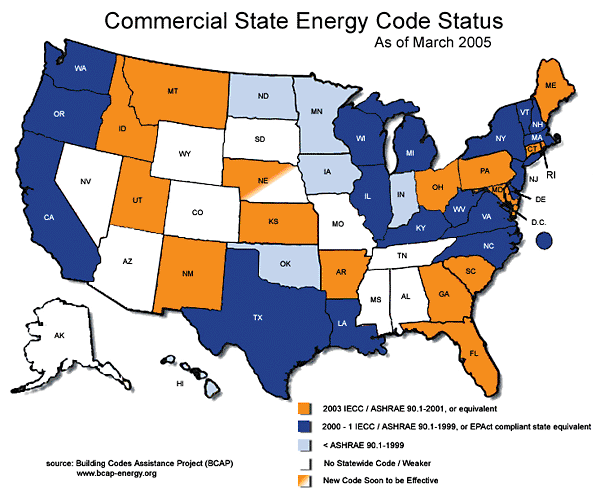Commercial Energy Codes Update
Nationwide, there have been a number of changes to the requirements for complying with commercial energy codes. Chances are, there could be new requirements in your state. The commercial energy code map indicates that the 2003 IECC and ASHRAE 90.1 codes are gaining momentum, as more states begin to comply with federal mandate of 1992 Energy Policy Act. The act requires all states to have an energy policy to meet or exceed ASHRAE 90.1 to reduce energy usage.
As the map on page 19 demonstrates, it is not easy to answer the question of what insulation thickness is needed for energy code compliance. It’s important to ask the energy code questions before starting the project.
It’s also important to consult ASHRAE tables such as the ones excerpted in this article. These show what a qualified person needs to determine the necessary thickness for energy code compliance. Many variables need to be defined prior to determining the insulation thickness required.
For instance, let’s look at Table 6.2.4.1.3. To determine the minimum pipe insulation thicknesses needed for 3-inch IPS pipe operating at 300 F, select the temperature from the far left column; select the pipe diameter from a column in the nominal pipe area. In this example, an insulation that has thermal conductivity in the range of 0.29 to 0.32 at 200 F mean temperature would be applicable. To meet the energy code requirement, you would need a minimum pipe insulation thickness of 3 inches.
Another variable is the climate zone. Tables 6.2.4.2A and 6.2.4.2B reference heating HDD65–heating degree-day 65 F. This refers to a daily mean temperature of less than 65 F. Each degree of mean temperature below 65 F counts as one heating degree-day. Annual heating degree-days are the sum of the degree-days over a calendar year.
Other Resources
The Building Codes Assistance Project (BCAP) provides assistance on building energy code adoption and implementation. The organization assists state and local regulatory and legislative bodies and help coordinate others representing environmental interests, consumers, labor and industry. BCAP can help states that request assistance, and because it is funded by the U.S. Department of Energy, its services are available at no cost.
BCAP was established in 1994 as a joint initiative of the Alliance to Save Energy, the American Council for an Energy-Efficient Economy and the Natural Resources Defense Council. As part of its outreach, BCAP produces a free bimonthly newsletter on the status of state energy codes, and maintains a website at www.bcap-energy.org. Resources available on the website include up-to-date information on state code activity, maps showing code adoption on a national level, as well as a listing of training opportunities and events on both the national and state levels.
Web Resources
The following websites contain important updates on energy codes.


